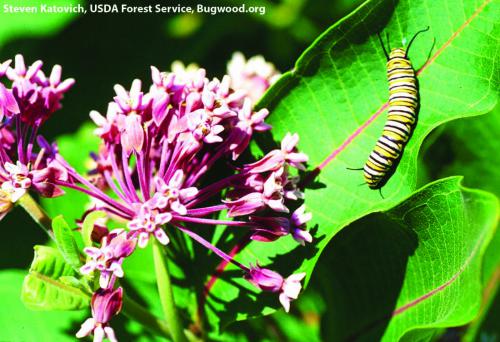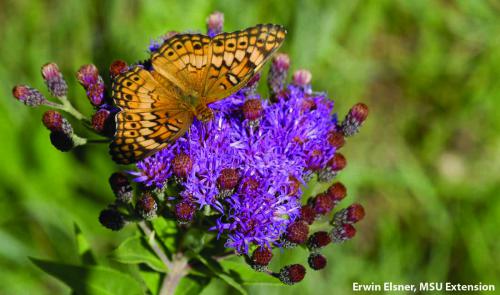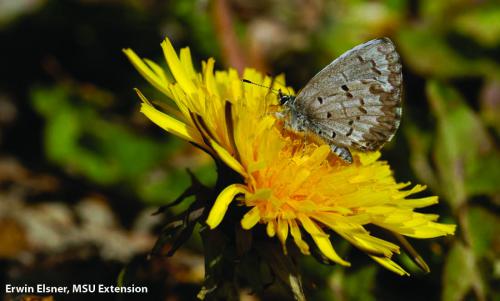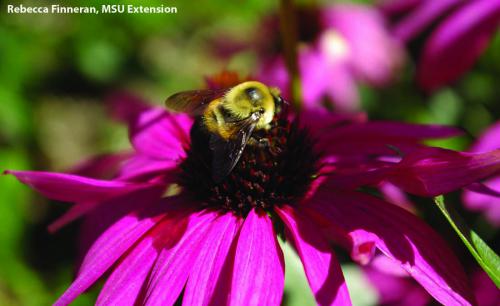How to control invasive pests while protecting pollinators and other beneficial insects
Pesticides should never be applied unless they are necessary to maintain plant health.

Pesticides should never be applied unless they are necessary to maintain plant health. Using preventive cover sprays, where pesticides are sprayed several times a year on a calendar basis, has been shown to create more pest problems than it solves. Not only do cover sprays create potential for pesticide runoff and increased human and pet exposure, they actually create pest problems by suppressing predators, parasitoids and diseases that keep plant pests under control. It is common to see outbreaks of spider mites, aphids and scale insects where pesticides are used. Only spray one plant at a time, and only if it is necessary.
Some key points about pollinator biology are good to remember if you have to use a pesticide, even if you are only treating one or two trees, shrubs or perennials. First, most bees and other pollinators forage during the day, so if you can spray at night or in the early morning, you can reduce the risk of accidentally spraying them. Second, pollinators are attracted to flowers. Anything that has flowers or is about to flower is a higher risk than a plant that is past bloom. If you can remove the flowers by mowing or pruning from around the treated plant, and anywhere your application may drift, you can significantly reduce risk to bees and other pollinators.
- Use low impact pesticides
- Considerations for using certain biopesticides
- Use EPA Reduced Risk products
- Low-impact miticides and insecticides not on the EPA Reduced-Risk list
Use low impact pesticides
Choose insecticides that are highly selective to a specific type of insect and so have low toxicity for others (signal word of Caution on the label or EPA Reduced Risk product). Other characteristics of low impact pesticides are those that break down rapidly after application and therefore have minimal impact on pollinators and natural enemies. However, using these products requires some knowledge about their relative toxicity to beneficial insects and their potential to cause leaf or flower injury (phytotoxicity). The following types of products have a minimal impact on beneficial insects.
Insecticidal soaps
Insecticidal soaps are applied as a foliar application (sprayed on plant leaves) and are effective on a wide range of plant pests when the soap spray comes into contact with the pest. Most commercially available insecticidal soaps are made of potassium salts of fatty acids and kill by disrupting the structure and permeability of insect cell membranes. Insecticidal soaps are most effective on soft-bodied insects such as aphids, adelgids, lace bugs, leafhoppers, mealybugs, thrips, sawfly larvae, spider mites and whiteflies. They are not effective on pests as a residue on the plant surface, and therefore are not toxic to pollinators after the spray dries. They can be safely used at any time to control pests on plants that are not attractive to pollinators. However, on pollinator-attractive plants, spray at dawn or dusk when pollinators are not present.
Generally, concentrations of insecticidal soaps exceeding 3% may cause some leaf or flower injury, and concentrations as low as 1.5% may injure sensitive plants. Read the product label for a list of sensitive plants and avoid spraying those. If uncertain of a plant’s sensitivity, spray a few leaves or flowers first and wait at least three days to watch for symptoms of spray injury, which include yellow, black or brown spots, brown (necrotic) edges on leaf and petal tips, scorch or discoloration. Some landscape plants known to be sensitive to insecticidal soap are horse chestnut, mountain ash, Japanese maple, sweet gum, jade plant, lantana, gardenia, bleeding heart, sweetpeas, crown-of-thorns and some cultivars of azaleas, begonias, chrysanthemum, fuchsias and impatiens.
It is best to purchase a commercial product formulated for use on plants rather than prepare your own spray from dish-washing detergents or other household cleaners because homemade recipes may be more toxic to plants. Most such products are detergents rather than true soaps, which can damage your plants. Only use products that are specifically formulated and labeled for use as insecticide. For more information on using insecticidal soaps, see Miller (1989), Gill and Raupp (1990) and Pundt (2004) in the reference section of this publication. Many insecticidal soap products are listed by the Organic Materials Review Institute (OMRI) at www.omri.org.
Horticultural oils
Horticultural oil is a term for the various oils used for pest control on plants. Most horticultural oils are lightweight and petroleum-based, but some are made from grains, vegetables or neem tree seeds. Like insecticidal soap, horticultural oils work best when the spray comes in contact with the pest. Once the oil spray dries, it does not have much effect and becomes safe for pollinators and other beneficial insects. Horticultural oil can be safely used at any time to control pests on plants that are not attractive to pollinators. However, on pollinator-attractive plants, spray at dawn or dusk when pollinators are not present.
Horticultural oils give excellent control of armored scales, such as Euonymus scale and oystershell scale, and can also be used for aphids, whiteflies, spider mites, true bugs, caterpillar and sawfly larvae and more. The recommended concentration of horticultural oils for pest control is usually 2%. However, even at 2%, some plants are sensitive to oils, including Japanese maple, red maple, hickory, black walnut, plume and smoketree (Cotinus coggygria). Plants reported as somewhat sensitive are Colorado blue spruce, redbud, juniper, cedar, cryptomeria and Douglas fir. Applying oils during high humidity or high temperatures may have a toxic effect on plant growth. Plant injury symptoms following an application of horticultural oil are discoloration, yellowing, leaf or flower browning (necrosis), black spots and terminal or branch dieback. It is best to spray a few plants first and observe them for three days for these phytotoxicity symptoms. Many horticultural oil products are listed by the OMRI.
Microbial or biopesticides
Several pesticides sold are derived from naturally occurring pathogens such as bacteria or fungi. These microbial or bio-pesticides vary in their toxicity to bees, butterflies and other beneficial insects. Some bioinsecticides, such as those derived from the fungus Beauvaria bassiana, are toxic to bees and should not be used where pollinators are present. Other bioinsecticides may have low impact on pollinators due to their low toxicity or short residual, which allows them to be applied in the evening or at dawn when bees are inactive.
Considerations for using certain biopesticides
The following active ingredients are found in products that have minimal impact on bees and other beneficial insects.

Bacillus thuringiensis (B.t.)
Products containing B.t. are made from a naturally-occurring soil bacterium. Many different B.t. products are available for landscape professionals and homeowners. Different strains of B.t. target specific pest groups, making them selective pesticides. For example, spores and crystals of Bacillus thuringiensis var. kurstaki (B.t.k.) are highly toxic when ingested by butterfly and moth larvae (caterpillars). The crystals containing the toxin dissolve only at an extremely high pH found in the caterpillar’s gut. B.t.k. is not toxic to bees. However, avoid spraying or allowing spray to drift onto favored food plants of caterpillars such as milkweed, the sole food source for monarch butterfly caterpillars.
Another strain of B.t., B.t. galleriae (B.t.g.), targets several species of beetles in the adult and larval stages including scarab beetles (e.g., Japanese beetle), flat headed beetles (e.g., emerald ash borer), weevils and leaf beetles. B.t.g. is not toxic to bees or butterflies, but applications should be avoided where predatory beetles are active. B.t. galleriae is now available at garden centers and recent testing indicates that it will control Japanese beetle adults for two weeks after it is sprayed. It will not harm pollinators, but it is toxic to monarch caterpillars.
While a B.t. strain works well for its target pest, it also breaks down quickly in sunlight, becoming ineffective after a few days. This makes B.t. very safe for pollinators, predatory insects and mammals. B.t. can be sprayed even when bees or butterflies are present. Many B.t. products are OMRI listed.
Metarhizium
The fungus Metarhizium anisopliae is found naturally in soils and infects and kills insects. Commercially available products of M. anisopliae (e.g., Met52) target thrips, weevils, whiteflies and mites on ornamentals, and ticks in turf. Once the product is sprayed on the foliage or drenched in the soil, the spores attach to the surface of the insect, germinate and penetrate the insect, multiply and kill it. M. anisopliae does not detrimentally impact honey bees and is being studied as a bio-insecticide of varroa mites, a pest of honey bees.
Chromobacterium subtsugae
This naturally occurring bacterium is used in a fermentation process that produces a product with insecticidal properties (e.g., Grandevo PTO). It is a broad spectrum bio-insecticide/miticide that controls or suppresses insect and mite pests on ornamentals and turf. It has multiple modes of action including oral toxicity (stomach poison), repellency and reduced reproduction. This product is applied as a foliar application and targets numerous caterpillar species in addition to aphids, whiteflies, thrips, psyllids, lace bugs, chinch bugs, mites and certain beetles. It suppresses a broad number of caterpillar species and should not be sprayed or allowed to drift in known habitats for threatened or endangered species of caterpillars and butterflies, such as fields with milkweed where monarch butterfly caterpillars feed. This product may repel bees for up to six days, so time applications to avoid disrupting pollination. Grandevo PTO (active ingredient C. subtsugae) is an OMRI listed product.

Azadirachtin
Azadirachtin is the active ingredient extracted from seeds of the tropical neem tree. Bio-insecticides with azadirachtin act as an insect growth regulator (IGR) in addition to being an anti-feedant and repellant to insects. It is effective at controlling insect immature stages and is broadly labeled for adelgids; aphids; caterpillars such as budworms, tent caterpillars and webworms; beetles such as Japanese beetles, emerald ash borers, weevils and elm leaf beetles; leafhoppers; leafminers; mealybugs; psyllids; sawflies; scales; thrips; and whiteflies. Azadirachtin must be ingested to be toxic and, when applied as a foliar spray, has short residual activity, making it unlikely bees and other pollinators will be affected (no longer toxic after about two hours for bees). Direct contact has shown no effect on worker honey bees. Azadirachtin products can be safely used at any time to control pests on plants that are not attractive to pollinators. However, on pollinator-attractive plants, spray during late evening, night or early morning when pollinators are not present to minimize contact with adult bees that could potentially bring azadirachtin back to the nest where larvae are present. Many azadirachtin products are OMRI listed.
Spinosad
Spinosad is derived from a soil bacterium and affects the nervous system of insects and mites. It has contact activity, but is even more active when ingested. Several products containing spinosad are labeled for ornamental (e.g., Conserve) and agricultural uses to control a broad spectrum of pests including caterpillars, sawfly larvae, leaf beetle adults and larvae, thrips, leafminer and gall-making flies and emerald ash borer beetles. Spinosad is highly toxic to bees. However, toxicity is greatly reduced once the product has dried on the foliage, within three hours to one day depending on the product. Therefore, avoid use if bees are active, and if applications are needed, apply in the evening when bees are not active and product has time to dry. This product suppresses a broad number of caterpillar species and should not be sprayed or allowed to drift in known habitats for threatened or endangered species of caterpillars and butterflies. Some spinosad products are OMRI-listed and on the EPA Reduced Risk list.
Use EPA Reduced Risk products
In 1994, EPA established a Reduced Risk Program to expedite review and approval of conventional pesticides that pose less risk to human health and the environment than existing pesticides. (See EPA‘s Reduced Risk and Organophosphate Alternative Decisions for Conventional Pesticides.)
Reduced risk status is granted to products demonstrating one or more of the following attributes: low impact on human health; lower toxicity to non-target organisms; low potential for ground and surface water contamination; low use rates; low pest resistance potential; or compatibility with IPM practices. EPA does not require a signal word on the label of Reduced Risk products. Although not all EPA Reduced Risk products are harmless to pollinators and other beneficials, many do have reduced impacts.
The following active ingredients are found in products on the EPA Reduced Risk list and should have minimal impact on bees and other beneficial insects. One limitation to this list, and the bee warning labels on insecticides, is nearly all the pollinator data required by EPA before registration of a pesticide is fulfilled through toxicology tests with one species: the honey bee (Apis mellifera). Recent studies have shown native bees or wild bees are sometimes more susceptible to insecticides than honey bees. Another list of reduced-risk pesticides is the Xerces Society’s “Organic-approved pesticides minimizing risks to bees,” which is available at their website.

Chlorantraniliprole
This EPA Reduced Risk chemical interrupts the normal muscle contraction of insects, resulting in paralysis and death. It has limited systemic activity (moves internally within the plant) and can be applied as a foliar spray or through the soil. It is labeled against turf pests including caterpillars, white grubs, crane flies, billbugs, annual bluegrass weevils and spittlebugs, and ornamental pests including leaf-feeding caterpillars, lace bugs, aphids and birch leafminers, and as a bark spray for clearwing borers. Due to the activity of chlorantraniliprole against caterpillars and its long residual activity, applications should not be made on larval host plants of butterfly and moth pollinators. Chlorantraniliprole has negligible toxicity to bees, and is shown to have no impact on bumble bees. It has no direct impact on natural enemies, and so is compatible with IPM programs.
Acetamiprid
This neonicotinoid is classified as Reduced Risk by EPA. It kills insects by disrupting the nerve function. Acetamiprid is systemic and absorbed through the foliage or when applied as a basal bark spray. It is labeled to control a broad range of pest insects on ornamental plants including aphids, adelgids, caterpillars, European pine sawflies, mealybugs, leafhoppers, armored and soft scales, plant bugs, whiteflies, fungus gnat larvae, thrips and leafmining flies. Because acetamiprid is toxic to multiple caterpillar species, this product should not be sprayed or allowed to drift into known habitats for threatened or endangered species of caterpillars and butterflies. Although acetamiprid is less toxic to bees than other neonicotinoids, it is still toxic to bees directly exposed to the chemical. Apply acetamiprid in the evening, night or early morning when bees are not visiting blooming plants and the residue will not be harmful to bees. When the fungicide fenbuconazole is combined with acetamiprid, the mixture is about fivefold more toxic to honey bees than acetamiprid alone.
Tebufenozide
This EPA Reduced Risk chemical is an IGR that disrupts the molting of early instar caterpillars following ingestion. Tebufenozide is a selective chemical specific to caterpillars. It is only labeled for use in nurseries and on Christmas trees for a broad range of caterpillars. Tebufenozide is selective, making this product nontoxic to bees and most natural enemies. However, caution should be used to avoid application or drift to larval (caterpillar) food plants of butterfly and moth pollinators.

Pyriproxyfen
Pyriproxyfen is an EPA Reduced Risk chemical that acts as an IGR disrupting the molting process of immature insects (juvenile hormone disrupter). It has translaminar activity (moves through the leaves) and ovicidal activities. Pyriproxyfen provides very good control of certain scale insects including black scale, California red scale, euonymus scale, Florida wax scale, San Jose scale and snow scale. It also controls spotted tentiform leafminer and whiteflies, and suppresses aphids and mealybugs. Pyriproxyfen has low to moderate toxicity to bees. Be careful to avoid spraying or drift near honey bee hives and bumble bee nests. There should be little impact on butterflies or other beneficial insects. Phytotoxicity has been observed on the following plants: Salvia (Salvia spp.), ghost plant (Graptopetalum paraguayense), Boston fern (Nephrolepis exaltata), Schefflera (Schefflera spp.), Gardenia (Gardenia spp.) and coral bells (Heuchera sanguinea).
Pymetrozine
This EPA Reduced Risk pesticide disrupts the normal feeding behavior of aphids and whiteflies on ornamentals. The Endeavor label (active ingredient pymetrozine) states no precautions for honey bees and bumble bees. However, some toxicity has been observed in field studies. As a caution, apply pymetrozine in the evening, night or early morning when bees are not visiting blooming plants. Since this product is selective for aphids and whiteflies, there should be no impact on other pollinators or natural enemies.
Spiromesifen
Spiromesifen is a mite IGR labeled as an EPA Reduced Risk chemical. It is a lipid biosynthesis inhibitor and targets all stages of a broad range of mite species including spider, false spider, rust and tarsonemid mites and immature stages of whitefly species. The Forbid label (active ingredient spiromesifen) states no precautions for bees, but there are concerns about the systemic nature of this product and the potential exposure of bee larvae to this class of insecticide. Due to this concern, spiromesifen should be applied after bloom for flowering plants attractive to bees.
Acequinocyl
This EPA Reduced Risk miticide is a metabolic poison that kills spider mites by affecting energy production. It provides quick knockdown and long residual control for spruce spider mites and twospotted spider mites. Plants should be tested for sensitivity to acequinocyl, especially roses and impatiens. The Shuttle label (active ingredient acequinocyl) states no precautions for bees. Acequinocyl is considered nontoxic to bees and can be applied at any time. Since acequinocyl is selective for mites, other pollinators and natural enemies should not be affected.
Flupyradifurone
This EPA Reduced Risk insecticide is a novel butenolide insecticide that kills insects by disrupting nerve function. Flupyradifurone, marketed as Altus, is systemic and can be applied as a foliar spray or soil drench. It is labeled to control a broad range of sucking insects on ornamental plants including aphids, lace bugs, scales, leafhoppers, psyllids, mealybugs and whiteflies. Flupyradifurone is compatible with many beneficials and has no adverse effects on honey bees and bumble bees and can be applied before, during and after bloom. It is compatible with IPM programs.
Low-impact miticides not on the EPA Reduced- Risk list
Hexythiazox
This mite growth regulator disrupts mites’ normal development. It is effective against immature spider mites and eggs, has long residual activity and is applied at low rates. Hexygon (active ingredient hexythiazox) is selective for spider mites in the Tetranychidae family, which includes arborvitae spider mites, European red mites, honeylocust spider mites, Pacific spider mites, Southern red mites, spruce spider mites, strawberry spider mites, twospotted spider mites and Willamette mites. There is no bee precautionary statement on the Hexygon label and it is generally considered nontoxic to bees, although there is a caution about a potential short residual effect (about two hours) on alfalfa leafcutting and alkali bees. As a caution, apply hexythiazox in the evening, night or early morning when bees are not visiting blooming plants. Since hexythiazox is selective for mites, other pollinators and natural enemies should not be affected.
Buprofezin
Buprofezin is an IGR effective against nymphal stages of soft and armored scales (crawler stage), whiteflies, psyllids, mealybugs, planthoppers and leafhoppers. It works by inhibiting chitin synthesis, suppressing oviposition of adults and reducing egg viability. It is nontoxic to bees and is not disruptive to other beneficial insects and mites.
Etoxazole
Etoxazole is a selective miticide effective against most plant-feeding mites, but fairly safe for most predatory insects and mites. Etoxazole is practically nontoxic to adult honey bees.
Read the next article in this publication series: Do not spray pollinator-attractive plants with insecticides when open flowers are present
Or return to the beginning of this publication: How to protect and increase pollinators in your landscape



 Print
Print Email
Email





